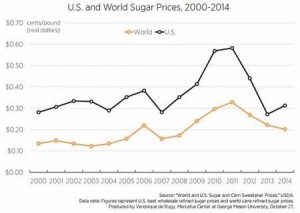Think Halloween Candy Is Expensive? Thank Federal Sugar Subsidies
< < Go Back
As Americans prepare for trick-or-treaters on Friday, many are finding that candy is not exactly cheap. Veronique de Rugy of the Mercatus Center explains why our federal sugar policy raises the price of that candy.
According to the Nielsen Company, Americans purchase 600 million pounds of candy for Halloween — 4 percent of the annual candy total. Each year, Americans eat 15 billion pounds of candy, and candy sales this year are expected to be at $2.2 billion, higher this year than last year’s total of $2.08 billion.
According to de Rugy, the price of candy is artificially inflated due to a federal sugar program that provides support to domestic sugar producers:
– Sugar imports are taxed, preventing competition from lowering the price of sugar.
– The federal government has a board which decides how much sugar domestic companies can produce annually. If a company exceeds that quota, the sugar must be stockpiled or destroyed altogether.
– Sugar companies also benefit from loans backed by taxpayers.
What does all of this mean for the cost of candy? Sugar in the United States costs double what it costs in the rest of the world. According to Mark Perry of the American Enterprise Institute, Americans could have saved $3.86 billion in 2011 had they been able to purchase sugar at the world price rather than the U.S. price.
More From NCPA:




